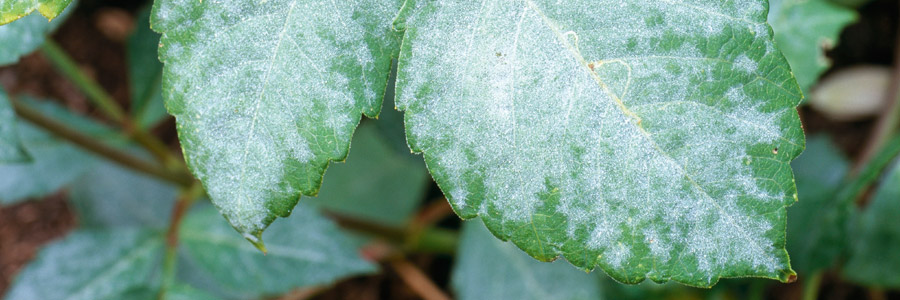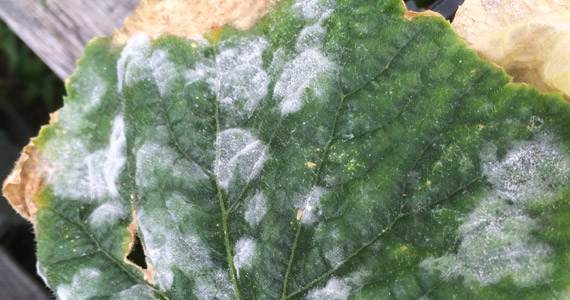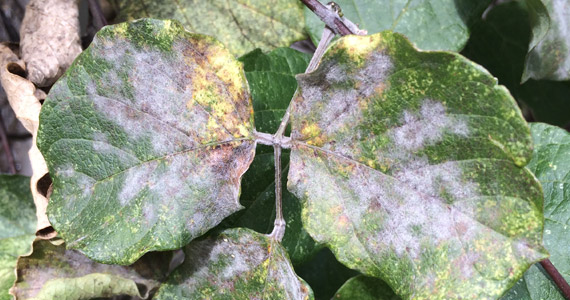
About mildew
- What is mildew? The term mildew refers to a group of phytopathogenic fungi that causes diseases in plants.
- What can you see? In general, mildew is found on the upper side of the leaf, but there are exceptions. One type of mildew only grows on the underside of the leaf. The leaf looks as if it has been dusted with powder.
- What can you do? Keep humidity low and keep your growing area clean.
About powdery mildew
Powdery mildew is also known as Oidium. Before any symptoms become visible the leaf starts to develop blister-like patches, which is followed by the characteristic white powder where the blister was. The leaf looks as if it has been dusted with powder. In general, mildew is found on the upper side of the leaf, but there are exceptions. One type of mildew only grows on the underside of the leaf, so it’s no surprise that this often gets overlooked. However, as the disease advances, the leaves can end up being completely covered in this white layer and it can even colonize the fruits, with subsequent losses in crop size and quality.

How to prevent the disease?
The best treatment against these types of fungi is prevention; once they have set in and developed, they are very difficult to eradicate, sometimes even with chemical fungicides. Try to prevent spores coming in from elsewhere and contaminating your plants by keeping your growing area clean. You can do this by using only clean equipment and washing your hands thoroughly before entering.

Identification
How To Identify Powdery Mildew Damage
- Plants infected with powdery mildew look as if they have been dusted with flour.
- Powdery mildew usually starts off as circular, powdery white spots, which can appear on leaves, stems, and sometimes fruit.
- Powdery mildew usually covers the upper part of the leaves and affects the older leaves first; the leaves turn yellow and dry out.
- The fungus might cause some leaves to twist, break, or become distorted.
- The white spots of powdery mildew will spread to cover most of the leaves or affected areas.
- The leaves, buds, and growing tips will become distorted as well. These symptoms usually appear late in the growing season.
Control and Prevention
How To Control Powdery Mildew
- Rubbing the infected leaves together can help partially remove the disease from your plants.
- Remove all the infected plant parts and destroy them. Remember, do not compost any infected plant, as the disease can still be spread by the wind.
- Spray infected plants with fungicides. Effective fungicides for powdery mildew treatments or cures include sulfur, lime-sulfur, neem oil, and potassium bicarbonate.
How To Prevent Powdery Mildew
- Choose plants that are resistant or tolerant to powdery mildew.
- Powdery mildew thrives in hot and humid weather, so avoid overhead watering to reduce humidity. Also selectively prune overcrowded areas to increase air circulation; this also helps reduce humidity for your plants.
- Spray your plants with fungicides according to their directions. If you don’t want to use fungicides, try spraying your plants with a solution of 1 teaspoon baking soda in 1 quart of water. Remember to spray your plants thoroughly.
Plumeria that grow in crowded, humid or shaded conditions are susceptible to powdery mildew, a form of mold. Powdery mildew is a common fungal disease that affects many types of plants, from squash to plumerias. The signature symptom of powdery mildew is white or gray powdery spots on the upper sides of plumeria leaves. The spots sometimes appears on flowers, buds, the undersides of leaves and new shoots. As the infection progresses, the leaves turn yellow, become distorted and drop off prematurely, and flower buds fail to open. The fungus overwinters in brown or black fruiting bodies.